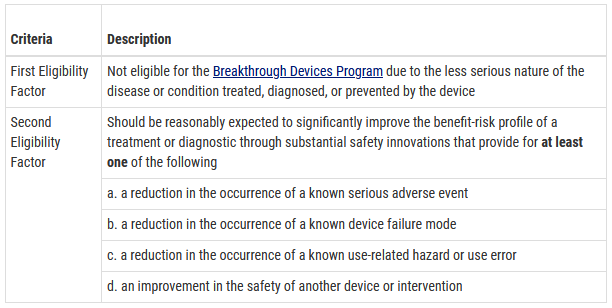Is STeP right for your medical device?
In 2021, due to the success of the Breakthrough Technologies program, the FDA created a new program called the Safer Technologies Program (STeP) to bring medical devices to market faster for conditions that are less serious than those covered by the Breakthrough Devices Program (see previous article). The device can be Class I, II, or III, and subject to PMA, 510(k), or De Novo marketing authorization.
What’s Covered
The most important requirement for a device to be accepted into STeP is that it must offer a significant safety improvement over current treatments.

Source: FDA
Sounds great, what’s the catch?
The STeP program is about two years old…but as of October 2023, data illustrating how many medical devices have received this designation is difficult to track down. A quick google search showed only two devices have made it to market, one in March 2023 and one in August 2023. Not exactly a well-trodden path for medical device makers.
And when you look closely at the benefits of the program, it starts to make sense as to why. First, the program is new, so assume the FDA is still making adjustments to it as they go. Second, none of the requirements are eased — you’re still subject to the same statutory standards, whether it’s PMA, 510(k), or De Novo, whether you have STeP designation or not.
Second, it is also worth noting that several times throughout the STeP FDA guidance document the phrase “as resources permit” appears. This may be a simple disclaimer, but it may also represent the FDA’s intention to prioritize Breakthrough Devices over STeP devices. It is unknown how resource constrained the FDA may be when it supports both programs.
The real benefit seems to be a promise that you’ll get answers from the FDA, and fast — which is a very real benefit. In our opinion, this sentence straight from the FDA is the key to understanding the value of the program, “Manufacturers can also expect interactive and timely communications, early engagement on Data Development Plans, sprint discussions, and senior management engagement to support the program” (emphasis mine).
In plain English, that means it’s the promise of a dedicated team to answer your questions and clarify points in a timely manner — and possibly the ability to escalate things to senior management to cut through red tape.
How Do I Apply for STeP?
You apply for STeP before anything else — it must be before applying for PMA, 510(k) or De Novo marketing authorization.
Submit a Q-submission with only the STeP request in it (don’t add on any other requests), and that should be clear on the cover page. The body of the submission will then contain everything else needed to support your request: a thorough device description, how it qualifies for STeP, data to show the improved safety profile over current devices, and the marketing authorization you will be seeking.
You’ll know right away if you are accepted into the program — the FDA has 30 days to ask for more information, and then must make a decision after 60 days. Keep in mind, those tight turn-around times cut both ways: if the FDA requests more information from you, you may only have a week (or less!) to reply (and as always — FDA replies are not one-liners, but multi-page packets).
So the benefit of STeP is speedy interaction with and full attention of the FDA. They have this shiny, new, funded program, and want to show success. If you are accepted into STeP, there are dedicated resources you can talk to throughout the approval process. Think of it as an airport lounge — lounge access won’t change your flight time, but the wait will be more comfortable and with lots of staff available to help you if you need it.
In our opinion, the small amount of additional work to file this Q-submission — 90% of the information in the STeP Q-sub will be needed for a submission anyway at some point — so is well worth the potential payoff of ending up at the ‘executive lounge’ at the FDA.
Can PTL help?
PTL Solutions has been a part of the STeP program from the beginning and can help with all your Q-submissions, even with the tight turnaround times of FDA requests for additional information. Let us help you craft a winning regulatory strategy that gets it right the first time.
Our team is highly experienced, with decades of experience guiding medical device manufacturers through the FDA regulatory process, and 80 products successfully brought to market.
The best way to get started is to book a free consultation with one of our regulatory experts. PTL will customize a path to market for your device that considers safety, speed, and budget.

